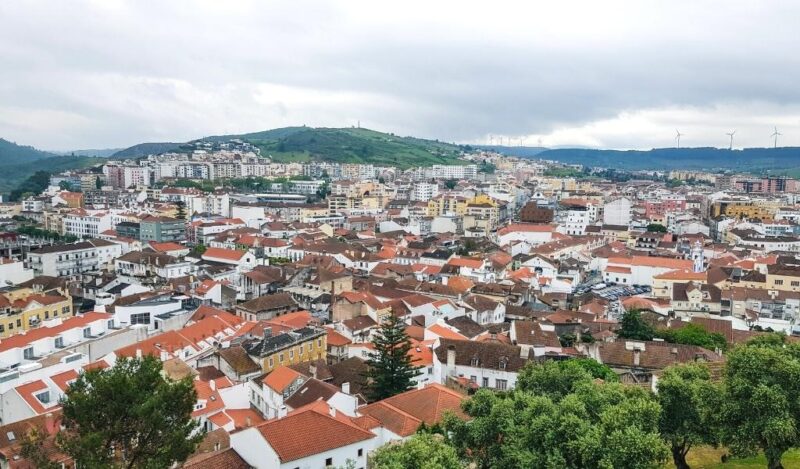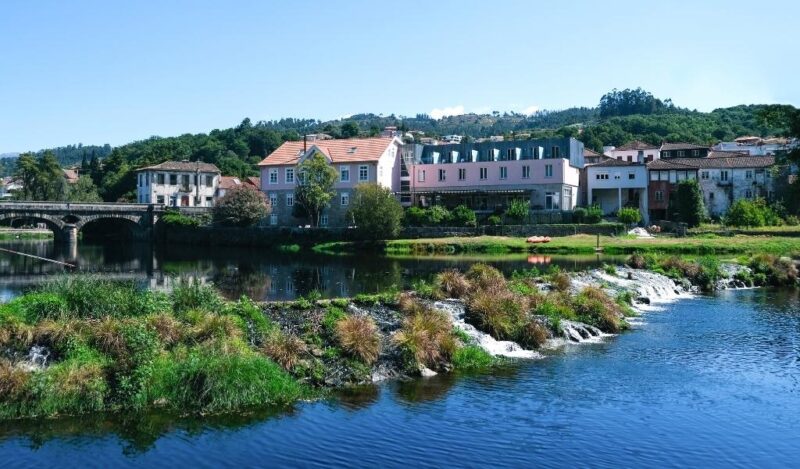Despite being a town, Belmonte is considered one of the “12 Historical Villages of Portugal” (a program created by the Portuguese government in 1991, to restore and enhance a series of villages in the Beira Interior region, older than the country itself).
Belmonte belongs to the Castelo Branco district and is located about 40 km from the Torre (the highest point in Serra da Estrela and mainland Portugal) and 20 km from another historical village: Sortelha. Besides, it’s famous because of its Jewish Community, which remained secret for many centuries!
So, do you want to know more about 1 Day In Belmonte: The Perfect Belmonte Itinerary? Keep reading!
This post may contain affiliate links, meaning I earn a small commission if you make a purchase, at no additional cost to you. Please read my disclosure & privacy policy for more information.
No time to read now? Pin it for later!


Brief History of Belmonte
The history of Belmonte dates back to the beginning of the 12th century when King Sancho I granted it the “Carta de Foral”. At the end of that century, the castle was built to form the defensive line of Alto Côa (together with the castles of Sortelha and Vila de Touro).
After several improvements over the centuries, the Belmonte Castle was entrusted to Fernão Cabral (its first Mayor-Alcaide) in the second half of the 15th century. And Fernão Cabral was none other than the father of Pedro Álvares Cabral, the Portuguese navigator who discovered Brazil in 1500!

At the same time, it’s known that there had been a Jewish community in Belmonte since the 13th century. In fact, there are records that prove the establishment of a synagogue and a “Judiaria” (a Jewish quarter) outside the walls, of the current Rua Direita and Rua da Fonte da Rosa!
However, with the expulsion of the Jews from Spain by the Catholic Kings (in 1492) and the forced conversion to Catholicism by King Manuel I (in 1496), a crypto-Jewish community was created, which managed to maintain its practices and traditions. religious in total secrecy until the 20th century!
Visiting Belmonte
As I mentioned earlier, Belmonte is mainly known as the “Jewish Nation” and the birthplace of Pedro Álvares Cabral. And while you can visit this Historical Village of Portugal in just one day, there are many things to see and do!
As a matter of fact, I had already been to Belmonte when I was younger and this time I ended up visiting it on two afternoons. This is because I insisted on exploring the village with a Jewish tour guide, an experience which I highly recommend!
Honestly, some of the 12 Historical Villages of Portugal can be visited in one morning or afternoon, as is the case of Castelo Mendo, Idanha-a-Velha, Linhares da Beira, Marialva, Piódão, or Sortelha. As for the others, it depends on the number of monuments you want to include in your itinerary.
Since Almeida, Belmonte, Castelo Novo, Castelo Rodrigo, and Monsanto are towns, it’s likely that you’ll need a day (or two) to explore them from one end to the other. And the same happens with Trancoso, which is a city. By the way, here’s the list of the 12 Historical Villages of Portugal:
- Almeida, in the Guarda district
- Belmonte, in the Castelo Branco district
- Castelo Mendo, in the Guarda district
- Castelo Novo, in the Castelo Branco district
- Castelo Rodrigo, in the Guarda district
- Idanha-a-Velha, in the Castelo Branco district
- Linhares da Beira (or simply Linhares), in the Guarda district
- Marialva, in the Guarda district
- Monsanto, in the Castelo Branco district
- Piódão, in the Coimbra district
- Sortelha, in the Guarda district
- Trancoso, in the Guarda district
Belmonte Itinerary
Belmonte Castle
The Belmonte Castle is the town’s most famous postcard. The monument was founded in 1258 by King Afonso III but lost its military function less than two centuries later. In 1446, Afonso V handed over the medieval castle to the nobleman Fernão Cabral, who converted it into his residence: the Cabral Palace.

The Belmonte Castle is open every day (except on Mondays), from 10 am to 1 pm and from 2:30 pm to 5:30 pm, with the last entry being at 5 pm. The ticket costs €2 but there’s a special price of €1.50 for children and young people from 6 to 18 years old, Youth Card or Student Card holders and retired people.
Santiago Church and Cabral Pantheon
The Santiago Church was constructed in the first half of the 13th century, in Romanesque style. And its location in Belmonte wasn’t chosen by chance: this church is part of the Portuguese Way to Santiago, the pilgrimage to the Spanish city of Santiago de Compostela, one of the most important pilgrimages in Europe!


In 1483, an adjacent chapel was built to serve as the Pantheon of the Cabral family. The Santiago Church and Cabral Pantheon operate from Tuesday to Sunday, from 10 am to 1 pm and from 2:30 pm to 5:30 pm. Admission costs €1 or €0.50 (for children and young people from 6 to 18 years old, Youth Card or Student Card holders, and retired people).
Santo António Church & Calvário Church
The Santo António Chapel and the Calvário Chapel are located very close to the Belmonte Castle and the Santiago Church & Cabral Pantheon. The older of the two is the Santo António Chapel, which dates back to the 15th century and features a coat of arms of the Queiroz, Gouveia, and Cabral families.


The Calvário Chapel (ie, Calvary Chapel) was built in the 19th century and is a clear example of neo-Gothic religious architecture. Inside, there are several decorative elements alluding to the Passion of Christ – hence the name of the chapel – such as the crown of thorns, the hammer, the spear, and swords.
Bet Eliahu Synagogue
The Bet Eliahu Synagogue was designed by architect Neves Dias and inaugurated in 1996, 500 years after the edict of King Manuel I, which ordered the expulsion from the country of all Jews (and Muslims) or the conversion to Christianity.
The temple is oriented towards Jerusalem and has two elements representative of Judaism in its decoration: the Hanukkah candle holder on the main door and railing, and the Star of David on the gates.
In the side garden, there’s also a Hanukkah, which is lit during this Jewish festival. The name Bet Eliahu is a tribute to the Jew who ordered the construction of the Synagogue of Belmonte, being that “bet” means “house” in Hebrew.

Old Municipal Council & Belmonte Pillory

Pillory Square (or Republic Square) is the heart of the town. Here, the Old Municipal Council and, of course, the Pillory that gives it its name, stand out.
The building of the Old Municipal Council has existed (at least) since the 15th century when the first records were registered. It’s characterized by its rectangular plan and the bell tower in the center.
Today, this iconic monument in Belmonte is home to the Historical Villages of Portugal and the Portuguese Network of Jewish Quarters.
The Pillory adorns the center of the square and is made up of three steps. However, this isn’t the original pillory, since the first had four steps and a “cage” at the top.
Jewish Museum of Belmonte
Did you know that the Jewish Museum of Belmonte was the first museum in Portugal entirely dedicated to Judaism and the Portuguese Jewish communities (in this case, from the regions of Beira Interior and Trás-os-Montes)? The space opened in 2005 and is one of the most visited tourist attractions in this historical village.
For that reason, I decided to write a complete guide about the Jewish Museum of Belmonte. This article includes not only all the practical information about the museum (ie opening times, prices, and access) but also a brief history of the museum and the must-see pieces in its collection!
Statue of Pedro Álvares Cabral
As you may have already noticed, Pedro Álvares Cabral is a very important personality for the town of Belmonte. So it’s no big surprise that the municipality erected a statue for him!
This nobleman, a member of one of the most influential families in the region, became a military commander and navigator, leading the second Portuguese Armada to India in 1500.
Pedro Álvares Cabral‘s fleet of thirteen ships never reached the Asian continent but ended up discovering the Island of Vera Cruz or (Land of Vera Cruz): present-day Brazil.
Interestingly, the Statue of Pedro Álvares Cabral is located a few meters from the Museum of the Discoveries.

Museum of the Discoveries

The Museum of the Discoveries (also known as the Interpretation Center “Discovering the New World” – DNM) occupies the Solar dos Cabrais, the former residence of the Cabral family.
As its name implies, this museum portrays the Age of Portuguese Discoveries – a period of Portuguese History that’s already over 500 years old! The visit is very interactive, with dozens of videos, photographs, animations, and life-sized replicas.
The Museum of the Discoveries is open from Tuesday to Sunday, from 10 am to 1 pm and from 2:30 pm to 5:30 pm. Tickets cost €5, but there are two reduced fares: €3 (for Youth Card or Student Card holders) or €3.5 (for children and young people aged 6 to 18, and retired people).
Centum Cellas
The last stop on this Belmonte itinerary is about 3-4 km from the historic center, so this is the ideal time to pick up your car. The destination is the ruins of the Roman Tower of Centum Cellas, an enigmatic construction whose true functionality has never been discovered!

Founded possibly in the 1st century AD, Centum Cellas may have been a village (ie, a typical Roman Empire rural dwelling), a temple, or even a prison! The opinions of archaeologists and historians differ, but it’s known that the monument had two floors and that there were other stone structures around it.
Map of the Belmonte Itinerary
Share this blog post on your social media!
More Posts about Portugal
4 Best Monasteries In Portugal (That You Should Visit This Year)
5 Best Palaces In Sintra (That You Should Visit This Year)
1 Day In Penafiel: The Perfect Penafiel Itinerary
More Posts about Travel Itineraries
1 Day In Penafiel: The Perfect Penafiel Itinerary
1 Day In Torres Vedras: The Perfect Torres Vedras Itinerary
2 Days In Arcos De Valdevez: The Perfect Arcos De Valdevez Itinerary
What Photography Gear Do I Use?
- Camera Body: Fujifilm X-T4 Mirrorless
- Camera Lens: Fujinon XF 18-55 mm F2.8-4 R LM OIS
- Tripod: Manfrotto Compact Action
- Small Tripod: Manfrotto PIXI Mini
- Smartphone Adaptor: Manfrotto PIXI Clamp
- Memory Card: SanDisk 128GB Extreme PRO SDXC





